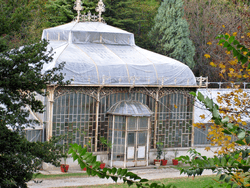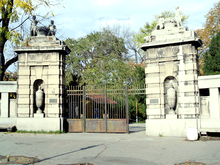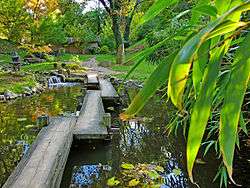Jevremovac


Jevremovac Botanical Garden (Serbian Cyrillic: Ботаничка башта Јевремовац) is the botanical garden of the University of Belgrade and also an urban neighborhood of Belgrade, the capital of Serbia. It is located in Belgrade's municipality of Stari Grad and is an administered by the University of Belgrade's Biology School.
Location
Jevremovac is located in the westernmost part of the Palilula neighborhood, but after the changes of the municipal administrative borders in 1952, 1955 and 1957, it didn't become part of the municipality of Palilula but of Stari Grad. It is bounded by the Boulevard of despot Stefan and the streets of Takovska, Dalmatinska, Palmotićeva and Vojvode Dobrnjca.
History

The botanical garden was founded in 1874 by the decree of the Ministry of Education of the Kingdom of Serbia, at the suggestion of Josif Pančić, famous botanist who also became its first manager. In 1889, king Milan Obrenović donated the estate (inherited from his grandfather Jevrem Obrenović) to the Great School in Belgrade for the purpose of the construction of botanical garden, provided that it be named "Jevremovac" (Serbian for "Jevrem's garden"), after his grandfather. It exists to this day at the same location and under the same name and gave its name to the small surrounding neighborhood. Apart from its founder, Josif Pančić, very important for the development and growth of Jevremovac was its longtime manager (1906–34), Nedeljko Košanin under whose supervision botanical garden lived its 'golden age'. Present manager (2011) is prof. Petar Marin.
After World War II, new Communist authorities suppressed public usage of word Jevremovac, so it was simply known as "botanical garden" until the 1990s when Jevremovac came into common usage again. Also, arboretum was very neglected for decades and only recently began its partial renovation and beautification but Jevremovac soon became popular again and today, with 60,000 visitors a year, it is the second most visited natural monument in Serbia, after the mountain and national park Kopaonik.
Arboretum
The arboretum spreads over the area of 50,000 square metres of open space and includes over 250 species of trees and bushes including local, European and exotic plants. The total plant population now includes about 500 trees, bushes and herbaceous plants. Besides the open space, the arboretum also includes a greenhouse and the Institute of Botany's premises (administrative building, herbarium, library, lecture hall and laboratories). In front of the administrative building, a bust of the former manager Nedeljko Košanin was erected in 2006, celebrating 100 years of his appointment. Part of the arboretum is Japanese garden since May 18, 2004. The Japanese garden is created by Vera and Mihailo Grbic, landscape architects.
The greenhouse, built in 1892, covers an area of 500 m². At the time of its construction, it was one of the biggest and most beautiful greenhouses in this part of Europe. Numerous tropical and sub-tropical plants are being nursed, including Canary Island Date Palm, European Fan Palm, and Peruvian cactus (Cereus peruvianus). The greenhouse is protected by the law for its architectural values.
The herbarium accommodates rich collections of plants originating from the Balkan peninsula and the rest of Europe containing around 120,000 herbarium sheets and over 300,000 dried specimens. The library is one of the oldest and the largest in the area. Apart from 200 scientific and professional magazines it also accommodates over 6,000 books.
The arboretum is open to visitors from May 1 to November 1 (09.00 a.m. – 07.00 p.m.).
Future
It is planned that 500 new species of plants will be planted on the new area of 900 m² (which will raise the overall number of species to 2,800), beautification of the entire garden and complete renovation of the greenhouse. The projected number is 4,000 different species and 100,000 visitors yearly.
External links
Coordinates: 44°48′56.9″N 20°28′23.6″E / 44.815806°N 20.473222°E
